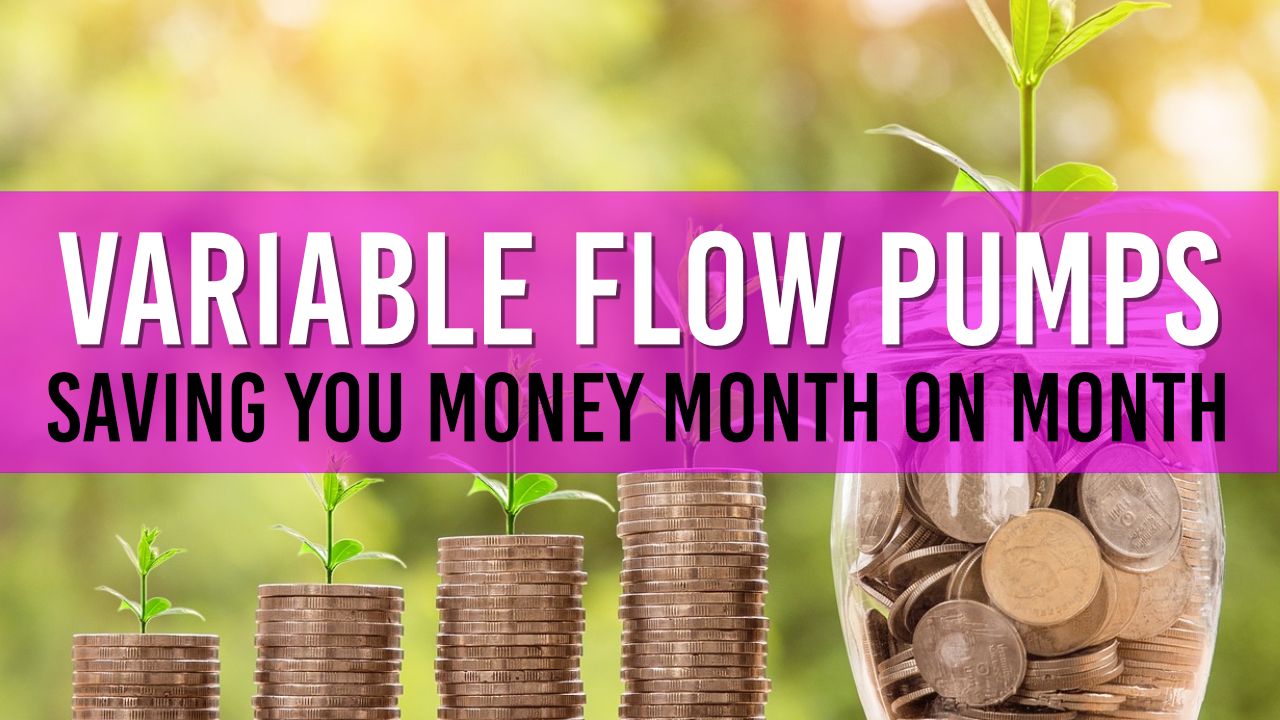Are Variable Flow Pond Pumps worth the money?
In short, yes! If your current Pond Pump is more than a few years old, you can take advantage of controlling your energy bill by slowing down your pond pump in the colder months.

Table of Contents
Electricity bills have been soaring, and it's no surprise that every homeowner is on the lookout for ways to cut down on their monthly expenses. In this energy-conscious era, variable flow pond pumps have emerged as a shining beacon of hope for many! 🌟 They're not just another gadget; they're a smart investment that helps pond owners take charge of their electric bills.
Diving into the nitty-gritty, let's decipher the distinction between your everyday pond pumps and the innovative variable flow pond pumps. Traditional pond pumps, while functional, operate at a consistent flow rate, giving you little to no control over your energy usage. On the flip side, variable flow pond pumps allow you to "control the water flow" and adapt according to your needs.
This customization is a game-changer! 🎮 It means you only use what you need, and in turn, you "save money". Why pay more when you can have the power to pay less? It's time to make a switch and embrace the future of pond pumps. 💧💸🌱
Are Variable Flow Pumps any Good?
When considering the worthiness of variable flow pumps, it's essential to weigh their attributes and how they fit into our everyday needs. One of the standout features of these pumps is their cost-effectiveness. By dialling down to a lower speed, you ensure they're not only energy-efficient but also cheap to run. Think of it as having a dimmer switch for your pond – you adjust according to your requirements! 💡💰
Come winter, when everything slows down and the cold sets in, there's no need to maintain the same water flow. The beauty of these pumps is you can turn them down during these chilly months, saving both energy and money. ❄️🔽
But wait, summer's here, and as the temperatures soar, our aquatic friends might need a bit more oxygen and cleaner water. With variable flow pumps, as the heat rises, you can effortlessly turn up the flow, ensuring optimal water quality and creating a thriving environment for your pond's ecosystem. ☀️🔼💦
In a nutshell, variable flow pumps offer an adaptable solution tailored to your pond's needs across varying climates. So, are they any good? Absolutely! They're not just good; they're smart, adaptive, and easy on the wallet. 👌🌿🐠
What Size Variable Flow Pond Pump Do I Need?
Selecting the right size for your variable flow pond pump is paramount. It's not just about getting the water to circulate; it's about ensuring a harmonious environment for your pond's entire ecosystem. You might wonder, how can you pinpoint that perfect pump size? Luckily, there's a handy tool for that! Use the pond water volume calculator to determine your pond's water volume, making your choice simpler and more accurate.
Here's why the right pump size matters:
- Efficiency and Savings: An appropriately-sized pump means efficient energy use. Picking an oversized pump, on the other hand, might seem like a good idea for 'extra power,' but it'll cost you more in the long run. Your bills will tell the tale.
- Pond Health: An overpowered pump can cause excessive water movement, leading to erosion of pond liners and disturbing the settled sediments.
- Wildlife Wellness: Too much force from an oversized pump can be harmful to fish, plants, and other aquatic life. Imagine living in a constantly turbulent environment; it's stressful and unhealthy.
- Balanced Ecosystem: A pond isn't just about water. It's an ecosystem with bacteria, plants, and fish that all play a role. An overpowering pump can disrupt this balance, leading to issues like algae overgrowth.
In essence, while choosing your pond pump, think of it as picking the heart for your watery sanctuary. Too weak, and it won't support life. Too strong, and it might just cause more harm than good. Your pond deserves the perfect balance, and with the right tools and knowledge, you can provide just that! 🌱🐟🌊
Why Should I Lower My Variable Flow Pump Speed in Winter?
Winter brings a serene hush over our surroundings, and even the bustling life in your pond slows down during these chilly months. But did you know that it's also the ideal time to adjust the speed of your variable flow pump? Here's why:
- Less Fish Waste: As the temperature dips, the metabolic rates of fish decrease. This means they eat less, resulting in reduced waste. With the decline in waste production, there's less need for robust water circulation to break down and distribute this waste.
- Autumn's Aftermath: By the time winter rolls around, most of the leaves, twigs, and debris have already found their way into your pond during the autumn months. With the majority of this debris already settled, there's no need for vigorous water movement to keep it suspended or to push it toward filtration systems.
- Energy Efficiency: With the reduced necessity for high-speed circulation, you can lower your pump speed, leading to significant energy savings during the winter months. It's eco-friendly and pocket-friendly!
- Stress Reduction for Aquatic Life: A slower flow can create a more stable and less turbulent environment, reducing stress for your pond's inhabitants during the colder months.
- Limiting Ice Formation: A gentler flow can help prevent the rapid formation of ice on the surface, ensuring that there's always an area of the pond where gases can exchange, vital for the health of fish and plants beneath.
Lowering the speed of your variable flow pump in winter aligns with nature's rhythm, ensuring a harmonious and thriving pond environment throughout the year. 🐟🌱❄️🌊
Why Do I Increase My Pump Speed in the Spring/Summer?
As winter's icy grip loosens and the world awakens to the warmth and vibrancy of spring and summer, our ponds too undergo significant changes. With the rise in temperatures and increased activity in your aquatic paradise, adjusting the speed of your variable flow pump becomes essential. Here's why:
- Hungry Fish, More Waste: As the days lengthen and temperatures rise, fish become more active and their metabolic rates increase. This means they eat more, and in turn, produce more waste. An elevated pump speed ensures that this increased waste is effectively circulated and directed towards filtration systems for timely removal.
- Combatting Algae Blooms: Warm weather can sometimes be a double-edged sword for ponds. While it revitalizes aquatic life, it also provides the ideal conditions for algae blooms. Faster water circulation can help prevent stagnant water, which is a breeding ground for algae. Additionally, enhanced circulation ensures that essential nutrients are distributed evenly, rather than being monopolized by algae.
- Optimal Water Quality: With the hustle and bustle of spring and summer, maintaining water quality becomes paramount. A higher pump speed ensures better oxygen distribution, essential for both fish and beneficial bacteria, which play a pivotal role in breaking down waste and keeping the water clear.
- Regular Maintenance Reminder: As you adjust your pump's speed to adapt to the changing seasons, it's a perfect cue to also indulge in regular pond maintenance. Check your filters, ensure all equipment is functioning optimally, and inspect for any signs of disease or distress in your pond's inhabitants.
In essence, spring and summer are dynamic, lively times for your pond. By increasing your pump's speed, you're not just reacting to the changes; you're proactively ensuring a healthier, happier environment for all its residents. Embrace the warmth, and let your pond thrive in harmony with the season!
Which Brand Offers the Best Variable Flow Pond Pumps?
In the rapidly evolving world of pond maintenance, choosing the best variable flow pond pump can be as intricate as picking the right fish for your pond. Over the years, several brands have distinguished themselves with top-tier offerings. Let's dive into some of the frontrunners:
- Blagdon: Known for its commitment to quality and innovation, Blagdon has been a trusted name in the pond care community for years. Their variable flow pond pumps are often lauded for their durability and efficiency, making them a favorite among seasoned pond enthusiasts.
- PondXpert: Another heavyweight in the pond world, PondXpert brings together a fine blend of affordability and performance. Their pumps are not only user-friendly but also boast features tailored to ensure optimal pond health.
While Blagdon and PondXpert have cemented their places as market leaders, the rise in demand for variable flow pond pumps hasn't gone unnoticed by other manufacturers. This has led to the introduction of competitively priced yet effective products by several newer brands:
- Evolution: A brand that's quickly gaining traction for its value-for-money offerings, ensuring you get reliable performance without burning a hole in your pocket.
- allpondsolutions: Their name speaks for itself. Catering to a broad spectrum of pond needs, their variable flow pumps have carved a niche, especially among newer pond keepers.
- Bermuda: Focusing on both aesthetics and functionality, Bermuda's pumps are designed for those who believe a pond is as much a visual delight as it is an ecosystem.
- Hidom: Last but certainly not least, Hidom has made waves with its energy-efficient designs, marrying sustainability with top-notch performance.
Choosing the right brand ultimately boils down to individual preferences, pond size, and budget constraints. Each of these brands brings something unique to the table. Whether you're a novice dipping your toes into the world of pond care or a seasoned pro, there's a variable flow pond pump out there tailored just for you!
Crunching the Numbers - Saving £100 per year.
Understanding the potential financial savings between a 'normal' pump and a variable flow pond pump is crucial. Let's illustrate this using some clear-cut figures:
Normal 'Standard' Pump:
- Power consumption: 80w (year-round)
- Yearly consumption:
- 80w × 24 hours × 365 days = 700,800 watt-hours or 700.8 kWh/year
Variable Flow Pump:
- Summer consumption (assuming 6 months):
- 80w × 24 hours × 182 days = 349,440 watt-hours or 349.4 kWh
- Winter consumption (assuming 6 months):
- 10w × 24 hours × 183 days = 43,920 watt-hours or 43.9 kWh
- Combined yearly consumption for variable flow pump:
- 349.4 kWh + 43.9 kWh = 393.3 kWh/year
Savings:
- 700.8 kWh (normal pump) - 393.3 kWh (variable flow pump) = 307.5 kWh saved/year
Given the cost of electricity at £0.34 per kWh, then:
- Yearly savings: 307.5 kWh × £0.34 = £104.55 saved annually with a variable flow pump.
In essence, the choice is clear: opting for a variable flow pump not only benefits the environment but also your wallet, showcasing substantial yearly savings! 🌊💡💷📉
So, Variable Flow Pumps - Should I get one?
When it comes to the nitty-gritty of pond maintenance, the right equipment can make all the difference. You've likely heard a lot about variable flow pumps and are pondering the age-old question: "Should I get one?"
Here's my take on it:
If you already have a relatively new, energy-efficient pump, it might not be worth switching immediately. Modern pumps, especially those purchased in recent years, have come a long way in terms of efficiency. Yet, if your pump is a relic from years gone by, you're likely missing out on both the technological advancements and energy savings a newer model would bring.

Considering that variable flow pumps start at £80 and can go up to £280, the initial investment might seem steep. But here's the catch - if your older pump is gobbling up energy, the savings you'd make with a variable flow pump would let it pay for itself in as little as a year or two. And for the pump to genuinely be a value proposition, it would need to last at least 2 years – which, given the quality of most models, is a reasonable expectation.

Even during those scorching summer months when our instinct is to keep the pump at full throttle, you've got the freedom to tone it down just a tad. If you notice the pond water remains clear and your fish are swimming about, happily oblivious, why not dial down the power a bit? This small adjustment can lead to even more savings, padding your wallet a bit more.
In conclusion, upgrading to a variable flow pump can be a sound investment for those with older pumps. While it requires an initial financial outlay, the long-term benefits – both ecological and economical – are undeniable. But remember, always keep an eye on your pond's health and adjust accordingly. After all, happy fish in crystal clear waters is what it's all about!


